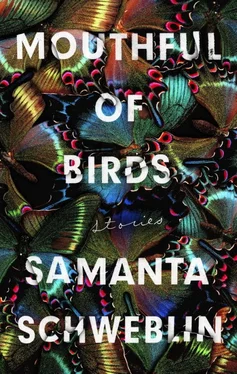Amid the crowd’s thundering applause, pushed forward by Corrales, Benavides makes his way toward Donorio, who has accompanied his words with a gesture of welcome. When the artist ascends to the stage and discovers the audience, the audience discovers in him the candid, humble features of pure and sincere creation. An excited ovation grows. It calms, or pauses briefly, when Donorio returns to the microphone. The monologue continues, but the audience does not take their eyes from the artist, who studies the ceiling and the walls. One hundred pairs of eyes expectantly follow the creative movement of the artist, so removed from their gazes and their praise.
“…something of the past remains in our collective memory, in the brilliant minds of our artists. Horror, hatred, death, all throb intensely in their persecuted minds…”
The artist discovers the large red velvet curtain to one side of the stage, behind which, one presumes, the work awaits. But what is it that so disturbs the artist? Why, in his simple, genius face, do pale glimmers of fear suddenly emerge?
“Gentlemen, ladies, what you are about to see goes beyond the superfluous emotions of common art. The work, this work, is the answer. Benavides, we’re listening,” says Donorio, and finally he leaves the microphone and cedes his place to the artist.
The audience waits. A man in blue runs to the microphone and lowers it to Benavides’s height. Benavides looks at the microphone like someone studying the weight of a crime, its punishment. He takes three steps forward. It seems he is going to speak.
Donorio looks for the complicit gaze of Corrales, who keeps his eyes on the artist, proud, as though looking at a child who has finally become a man. Benavides turns toward the curtain, and then back toward the audience. There is a thrilling silence. Then Benavides takes the microphone and says:
“I killed her.”
The message takes time to sink in. Once the audience processes the words and understands their meaning, they start slowly to applaud, moved. Euphoria breaks out. He says he killed her, they say to one another. Now, that is intense, they comment. Pure poetry, shouts someone in the back. The evening’s first tears of emotion fall. On one side of the stage Corrales nods along with the general murmur. Donorio moves the artist aside and returns to his position. Two men in blue come onstage and stand to either side of the red cloth. And Donorio says:
“Friends, the work…”
And like the sun brings light or like the artist discovers the most human truths, the curtain that had covered the creation now, slowly before the collective hunger, falls to the floor. And there is the work: violent, real, carnally alive. Donorio has lost the public’s attention, but even so he names it. He pronounces the title, savoring every letter:
“Violence.”
And the name lands: it descends to the crowd, and the crowd explodes.
The euphoria is uncontainable. People shove, try to climb onstage. A dozen men in blue form a barrier that blocks their advance. But the audience wants to see, and the barrier gives way. Excitement. Commotion. Something emanates from that work and it drives them mad. The sovereign image of the purple body. Death a few feet away. Human flesh, human skin. Giant thighs. Coiled in a suitcase. Squeezed into the leather. And the smell. The artist is still very close to the suitcase. Too exposed. His singular face stands out in the crowd, and they discover him. There is a surprising moment. When they realize it’s him, they lift him up, pass him from hand to hand. Corrales shouts: “The artist!” and some men in blue leave their human barricade to rescue Benavides. The audience, after hearing Corrales’s cries, lets go of Benavides, and he is lost among the people like a pearl in muddy water. After the stillness of married life, this unprecedented experience excites him. Hidden in the crowd, concealed even from the crowd itself, he moves through the euphoric bodies toward the nucleus of the disturbance. There are shouts, shoves, people fight to get a better view. Then Benavides feels a chasm open. It opens in front of him and separates him from the rest of humanity. Corrales sees it all, because he intuits the artist’s feelings. He has bet on Benavides’s future. He wishes, in the small man, for a kind of discovery: the ancestral pleasure of knowing oneself a creator, anxiety contained. He wants to see Benavides’s hands squeeze absent matter in the air, seek something to knead, sense the scant time and the colossal task, forget the leisurely latency of the common man. To see, before his candidly expectant eyes, the matter: dozens of bodies that throb and wait, the primordial mass to be rent, coiled, forced, to attain, majestically, under the expert hand of a practiced superior, the precise measures of the leather suitcase.
And though none of that happens, Corrales does not feel frustrated. His close relationship with human processes fills him with faith. Donorio smiles at him. Benavides, finally restrained by the custodians, withdraws through the main door.
With growing enthusiasm, everyone welcomes smiling waitresses bearing champagne. The opening has been a success.
Samanta Schweblin was chosen as one of the twenty-two best writers in Spanish under the age of thirty-five by Granta in 2010, and in 2017 she was named one of the Bogotá39’s best Latin American writers under age forty. Her first novel, Fever Dream, was shortlisted for the Man Booker International Prize in 2017. She is the author of award-winning story collections, and her stories have appeared in The New Yorker , Harper’s , and elsewhere. Her work has been translated into twenty languages. Originally from Buenos Aires, she lives in Berlin.
Megan McDowell has translated books by Alejandro Zambra, Mariana Enriquez, Lina Meruane, and Diego Zuñiga, among others. Her translation of Zambra’s novel Ways of Going Home won the 2013 English PEN Award for Writing in Translation, and her translation of Samanta Schweblin’s first novel, Fever Dream , was shortlisted for the 2017 Man Booker International Prize. McDowell’s story translations have appeared in The New Yorker , The Paris Review , Harper’s , Tin House , Granta , and Vice , among others. She is from Kentucky and now lives in Santiago, Chile.
Also by Samanta Schweblin
Fever Dream

What’s next on your reading list?
Discover your next great read!
__________
Get personalized book picks and up-to-date news about this author.
Sign up now.

RIVERHEAD BOOKS
An imprint of Penguin Random House LLC
penguinrandomhouse.com

Copyright © 2019 by Samanta Schweblin
English translation copyright © 2019 by Megan McDowell
Originally published, in Spanish and in somewhat different form, as Pájaros en la boca by Random House Mondadori in 2010
Penguin supports copyright. Copyright fuels creativity, encourages diverse voices, promotes free speech, and creates a vibrant culture. Thank you for buying an authorized edition of this book and for complying with copyright laws by not reproducing, scanning, or distributing any part of it in any form without permission. You are supporting writers and allowing Penguin to continue to publish books for every reader.
Читать дальше











![Саманта Швеблин - Дистанция спасения [litres]](/books/427178/samanta-shveblin-distanciya-spaseniya-litres-thumb.webp)



